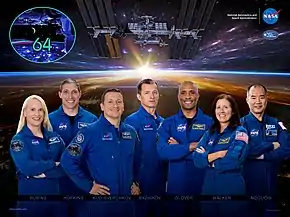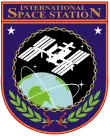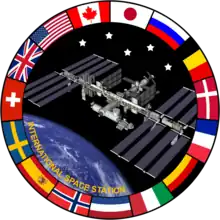 Promotional Poster | |
| Mission type | Long-duration mission to the ISS |
|---|---|
| Operator | NASA / Roscosmos |
| Mission duration | 177 days, 2 hours and 1 minute |
| Expedition | |
| Space station | International Space Station |
| Began | 21 October 2020, 23:32:09 UTC[1] |
| Ended | 17 April 2021, 01:34:04 UTC[1] |
| Arrived aboard | Soyuz MS-17 SpaceX Crew-1 Soyuz MS-18 |
| Departed aboard | Soyuz MS-17 |
| Crew | |
| Crew size | 3-10 |
| Members |
|
| EVAs | 5[1][2][3][4] |
| EVA duration | 26h08m |
 Expedition 64 mission patch  Expedition 64 crew portrait | |
Expedition 64 was the 64th long-duration expedition to the International Space Station (ISS), that began on 21 October 2020 with the undocking and departure of Soyuz MS-16. The Expedition started with the three crew members launched onboard Soyuz MS-17 and reached its full complement with the arrival of SpaceX Crew-1, the first operational flight of NASA's Commercial Crew Program (CCP).[5] As Crew-1 consists of a crew of four instead of three like the Soyuz, Expedition 64 marks the beginning of operations for crews of seven on the ISS. In the final week of the mission, Soyuz MS-18 and its three person crew joined the mission. The expedition ended on 17 April 2021 with the departure of Soyuz MS-17.[6]
Crew
| Flight | Astronaut | First part (21 October – 17 November 2020) |
Second part (17 November 2020 – 9 April 2021) |
Third part (9 April – 17 April 2021) |
|---|---|---|---|---|
| Soyuz MS-17 | Second spaceflight |
Commander | ||
Second spaceflight |
Flight Engineer | |||
First spaceflight |
Flight Engineer | |||
| SpaceX Crew-1 | Second spaceflight |
Off Station | Flight Engineer | |
Second and last spaceflight |
Off Station | Flight Engineer | ||
First spaceflight |
Off Station | Flight Engineer | ||
Third and Last spaceflight |
Off Station | Flight Engineer | ||
| Soyuz MS-18 | Third spaceflight |
Off Station | Flight Engineer | |
First spaceflight |
Off Station | Flight Engineer | ||
Second spaceflight |
Off Station | Flight Engineer | ||
Extravehicular activity
Several spacewalks for Expedition 63 were planned to carry out work on the scientific and power systems on the ISS. Delays to the NASA Commercial Crew Program left Chris Cassidy as the only crew member on the US Orbital Segment (USOS) for an extended period of time. The arrival of the Crew Dragon Demo-2 mission permitted four EVAs by Cassidy and Robert Behnken to replace the remaining nickel-hydrogen batteries on the S6 Truss with new lithium-ion batteries.[7]
The planned work for activating the Bartolomeo scientific package located on the outside of the Columbus laboratory module, delivered on SpaceX CRS-20, was postponed until Expedition 64.[8]
Ryzhikov and Kud-Sverchkov performed a spacewalk on 18 November 2020 to conduct initial preparations for the replacement of the Pirs docking compartment by the Nauka laboratory module, which lasted 6 hours and 48 minutes. This was the first EVA to be conducted from the Poisk airlock.[9] Coverage of the spacewalk, which NASA has designated "Russian Spacewalk #47", began at 14:30 UTC and lasted more than six hours.[10]
During late January through early March of 2021, NASA executed five spacewalks. The 27 January spacewalk, begun at 12:28 UTC and lasting 6 hours and 56 minutes, was conducted by Hopkins and Glover to install a Ka band antenna on Columbus in preparation for Bartolomeo's activation, replace a pin on the Quest Joint Airlock, and remove a grapple fixture on the P4 Truss for the beginning of a series of experimental solar array wing upgrades.[11][12]
The 1 February spacewalk, begun at 12:56 UTC and lasting 5 hours and 20 minutes, was conducted by Hopkins and Glover to conclude a four-year campaign, initiated by Shane Kimbrough and Peggy Whitson on Expedition 50, to replace the batteries on the Integrated Truss Structure.[13][14] Hopkins and Glover also installed and upgraded several cameras on the starboard truss, the Destiny laboratory, and the Kibo robotic arm.[15][16][11]
The 28 February spacewalk, begun at 11:12 UTC and lasting 7 hours and 4 minutes, was conducted by Rubins and Glover to install on the P6 Truss brackets for the experimental solar array upgrades, the main materials for which launched in June 2021 aboard SpaceX CRS-22.[17]
The 5 March spacewalk, begun at 11:37 UTC and lasting 6 hours and 56 minutes, was conducted by Rubins and Noguchi to continue the bracket installation work.[1][2][3][4] They had also initially planned to deploy a new airlock cover to strengthen Quest, replace a wireless video transceiver on the Unity node, route more cables on Bartolomeo, and vent and rearrange ammonia hoses. Rubins and Noguchi abandoned the planned additional work because they encountered difficulties with several bolts during the bracket installation.[17][18][19]
The 13 March spacewalk, begun at 13:14 UTC and lasting 6 hours and 47 minutes, was conducted by Hopkins and Glover to finish the work not taken up by Rubins and Noguchi, although they deferred installing clamps on Bartolomeo to a future spacewalk.[20]
References
- 1 2 3 4 "ISS Expedition 64". spacefacts.de. 17 October 2021. Retrieved 6 November 2021.
- 1 2 "Astronauts Kate Rubins and Soichi Noguchi began their spacewalk today at 6:37am ET to continue solar array modification work". Twitter. NASA. 5 March 2021. Retrieved 5 March 2021.
- 1 2 Garcia, Mark (5 March 2021). "Astronauts Begin Spacewalk for Solar Array Modifications". NASA. Retrieved 5 March 2021.
 This article incorporates text from this source, which is in the public domain.
This article incorporates text from this source, which is in the public domain. - 1 2 "The fourth spacewalk of the year concluded at 1:33pm ET, after an excursion lasting 6 hours and 56 minutes". Twitter. NASA. 5 March 2021. Retrieved 5 March 2021.
- 1 2 Burghardt, Thomas (17 November 2020). "Crew Dragon Resilience successfully docks, expands ISS crew to seven". NASASpaceflight.com.
- ↑ "ISS: Expedition 64". spacefacts.de. Retrieved 3 February 2023.
ISS Expedition 64 concluded with the undocking of Russian spacecraft Soyuz MS-17 on April 17, 2021 at 01:34:04 UTC.
- ↑ Corbett, Tobias (19 May 2020). "NASA outlines the near and far future of the Space Station". nasaspaceflight.com. Retrieved 21 May 2020.
- ↑ "Spacesuit Work and Heart Research Fill Crew Day – Space Station". blogs.nasa.gov.
 This article incorporates text from this source, which is in the public domain.
This article incorporates text from this source, which is in the public domain. - ↑ Potter, Sean (12 November 2020). "NASA TV Coverage Set for Russian Spacewalk" (Press release). NASA. Retrieved 14 November 2020.
 This article incorporates text from this source, which is in the public domain.
This article incorporates text from this source, which is in the public domain. - ↑ "NASA TV Main Page". NASA. 18 November 2020. Retrieved 18 November 2020.
 This article incorporates text from this source, which is in the public domain.
This article incorporates text from this source, which is in the public domain. - 1 2 Garcia, Mark (27 January 2021). "Spacewalk wraps up with upgrades on European lab module". NASA. Retrieved 28 February 2021.
 This article incorporates text from this source, which is in the public domain.
This article incorporates text from this source, which is in the public domain. - ↑ Strickland, Ashley (27 January 2021). "NASA astronauts Victor Glover, Mike Hopkins conduct spacewalk Wednesday". CNN. Retrieved 1 March 2021.
The spacewalk officially began at 6:28 a.m. ET and ended at 1:24 p.m. ET. It lasted for about six hours and 56 minutes.
- ↑ Garcia, Mark (6 January 2017). "Astronauts complete first of two power upgrade spacewalks". NASA. Retrieved 28 February 2021.
 This article incorporates text from this source, which is in the public domain.
This article incorporates text from this source, which is in the public domain. - ↑ Garcia, Mark (1 February 2021). "Spacewalkers complete multi-year effort to upgrade space station batteries". NASA. Retrieved 28 February 2021.
 This article incorporates text from this source, which is in the public domain.
This article incorporates text from this source, which is in the public domain. - ↑ Garcia, Mark (1 February 2021). "Spacewalkers wrap up battery work and camera installations". NASA. Retrieved 28 February 2021.
 This article incorporates text from this source, which is in the public domain.
This article incorporates text from this source, which is in the public domain. - ↑ Gohd, Chelsea (1 February 2021). "Spacewalking astronauts complete a space station battery upgrade years in the making". Space.com. Retrieved 1 March 2021.
- 1 2 Moran, Norah (28 February 2021). "Spacewalkers conclude today's spacewalk". NASA. Retrieved 28 February 2021.
 This article incorporates text from this source, which is in the public domain.
This article incorporates text from this source, which is in the public domain. - ↑ Brinkmann, Paul (5 March 2021). "Watch live: International Space Station astronauts set for space walk". United Press International. Retrieved 5 March 2021.
- ↑ Dunn, Marcia (5 March 2021). "Spacewalking astronauts tackle more solar panel advance work". Associated Press. Retrieved 5 March 2021.
- ↑ Garcia, Mark (13 March 2021). "NASA Astronauts Complete Year's Fifth Spacewalk at Station". NASA. Retrieved 16 March 2021.
 This article incorporates text from this source, which is in the public domain.
This article incorporates text from this source, which is in the public domain.

